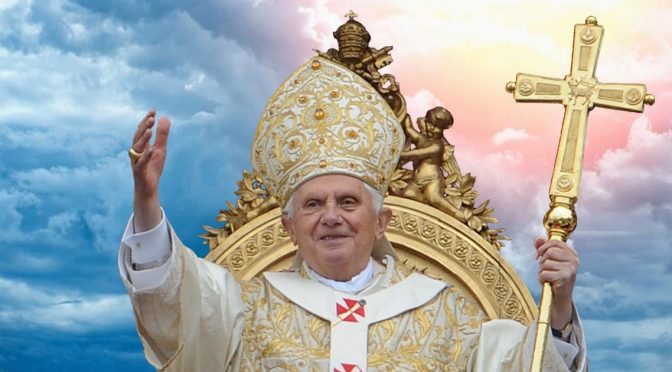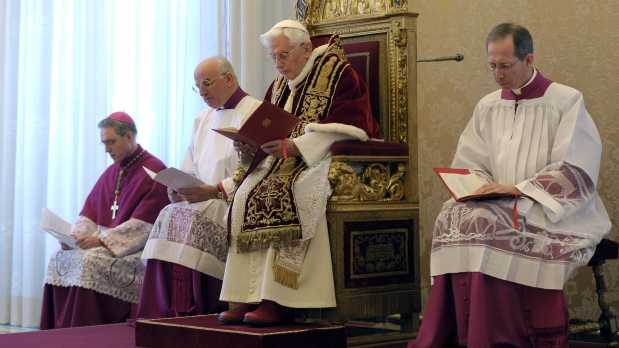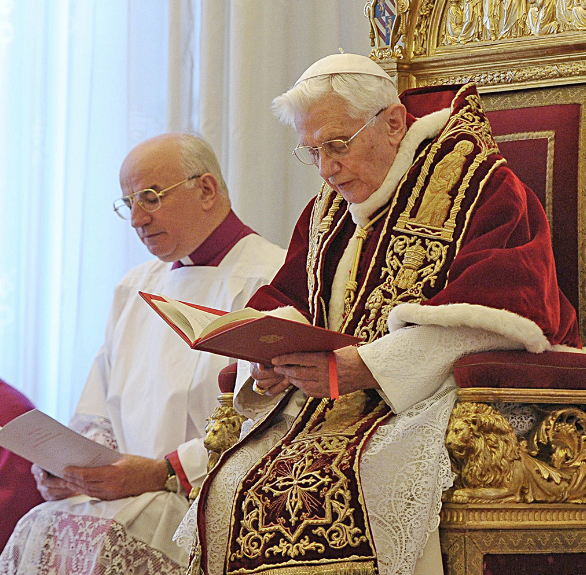Von Andrea Cionci
Ursprünglich veröffentlicht in der italienischen Tageszeitung Libero am 11. Juni 2020
In den letzten Tagen gab es im Internet eine Diskussion über die Kritik am Rücktritt Benedikts XVI. durch einen italienisch-amerikanischen Franziskaner-Latinisten, der Experte für scholastische Texte und kanonische Argumentation ist. Bruder Alexis Bugnolo, der über 9.000 Seiten des heiligen Bonaventura aus dem lateinischen Original übersetzt hat und die Sprache der Kirche wie nur wenige andere beherrscht, wurde von Decimo Toro auf YouTube interviewt.
Durch eine aufmerksame Lektüre der Rücktrittserklärung von Benedikt XVI., einem Faden der Logik, dem kanonischen Recht und der Bedeutung des lateinischen Originals folgend, behauptet Bruder Bugnolo, dass Benedikt den Text mit äußerster Geschicklichkeit und Subtilität und mit der Absicht verfasste, dass sie schließlich als ungültig erklärt werden würde. Auf diese Weise erlaubte Ratzinger der „Sankt-Gallen-Mafia“, der freimaurerisch-progressiven kirchlichen Lobby, die ihn zur Abdankung, zur übereilten Machtergreifung seines Nachfolgers und damit zur Enthüllung zwang, sich zu offenbaren. Benedikt trat in der Weise zurück, dass alle Handlungen, Ernennungen und Änderungen der Lehre, die von der „falschen Kirche“ vorgenommen wurden, schließlich auf einen Schlag hinweggefegt werden können, gerade wegen der Ungültigkeit seines Rücktritts vom Papsttum.
Aus diesem Grund, so Bruder Bugnolo, habe der Vatikan die Übersetzungen von Benedikts lateinischer Declaratio absichtlich gefälscht, um seine absichtlichen Fehler im Originaltext zu beheben, was aber in Wirklichkeit eine weitere Bosheit darstellt. Schon vor vierzig Jahren wussten Johannes Paul II. und der damalige Kardinal Ratzinger dank des Dritten Geheimnisses von Fatima, dass die schwul-freimaurerische Lobby des Klerus versuchen würde, die Macht an sich zu reißen, und aus diesem Grund änderten sie rechtzeitig den Codex des Kirchenrechts und richteten ein Notfallsystem ein, um im Falle einer Usurpation „die Bank zu sprengen“. Dies ist im Wesentlichen die These Bugnolos.
Um Anschuldigungen zu verhindern, dass seine Rekonstruktion der Ereignisse eine Verschwörungstheorie ist, zitiert Bruder Alexis nur die Dokumente der Vatikan-Webseite, die wir unten angefügt haben. Sie können alle auf der Website des Vatikans http://www.vatican.va/content/benedict-xvi/la/speeches/2013/february/documents/hf_ben-xvi_spe_20130211_declaratio.html eingesehen werden.
Es ist ganz klar, dass der Text der Deklaration Benedikts eine Reihe riesiger grammatikalischer Fehler enthält, die bereits 2013 von bedeutenden Klassikern wie Luciano Canfora und Wilfried Stroh festgestellt wurden. Das Fehlen des majestätischen Plurals „nos“, der in offiziellen Dokumenten immer verwendet wird, ist schon überraschend, aber Bruder Bugnolo, der mehr als 9000 Seiten des Heiligen Bonaventura übersetzt hat, hat vierzig weitere sprachliche Unvollkommenheiten festgestellt: Verben, die fälschlicherweise konjugiert werden, „decisionem“ anstelle des korrekten „consilium“, „vobis“ anstelle von „vobiscum“, die irrtümliche Verwendung von „explorata“, um „untersucht“ zu sagen, usw. Die vollständige Liste kann hier https://fromrome.info/2020/06/10/clamorous-errors-in-the-latin-of-the-renunciation-2/ eingesehen werden.
Aber das größte Problem ist die Konstruktion von Ratzingers Text, die den päpstlichen Rücktritt ungültig macht. Seit er 1983 von Johannes Paul II. und Ratzinger reformiert wurde, verlangt der Codex des Kirchenrechts den Rücktritt des „munus petrino“ – des Amtes (einschließlich Abgabe der Verantwortung) des Papsttums, das von Gott und vom heiligen Petrus kommt. (Zuvor musste der Papst nur „renuntio“ sagen – „Ich trete zurück“ – und die Änderung der Forderung von 1983 wurde wahrscheinlich hinzugefügt, um mögliche zukünftige päpstliche Abdankungen zu verstärken.)
In seiner Declaratio schreibt Ratzinger, dass seine Kraft aufgrund des fortschreitenden Alters „nicht mehr geeignet ist, das munus petrino angemessen auszuüben“. Er sagt jedoch keineswegs, dass er darauf verzichtet, sondern vielmehr: „Im Bewußtsein des Ernstes dieses Aktes erkläre ich daher mit voller Freiheit, auf das Amt des Bischofs von Rom…, zu verzichten“ – [declaro me MINISTERIO Episcopi Romae…renuntiare]. So zitiert er am Anfang der Declaratio das munus in allgemeiner Form, aber dann erklärt er formell nur den Verzicht auf das Ministerium, das nach Meinung vieler Experten für die Gültigkeit des Aktes völlig nutzlos ist. Es wäre so, als würde ein abdankender König sagen, er verzichte auf die Ausübung seiner Macht, ohne auf den Thron zu verzichten, den er durch göttliches Recht erlangt hat.
Unter anderem schreibt Ratzinger nicht einmal „renuntio“, sondern vielmehr „declaro renuntiare“, was nicht bedeutet, dass sein Rücktritt aufrichtig ist, so wie „der Liebe erklären“ nicht unbedingt „Liebe“ entspricht. Angenommen, Benedikt wäre unter Druck gesetzt worden – zum Beispiel vor die Wahl gestellt worden, entweder zurückzutreten oder den Vatikan in Konkurs gehen zu lassen (siehe dazu die bekannte Affäre um die Annullierung des vatikanischen SWIFT-Codes und die Sperrung vatikanischer Bankkonten, die in den Wochen vor dem Rücktritt im Jahr 2013 stattfand) – hätte er sich frei entscheiden können, „seinen Rücktritt zu erklären“ – was etwas ganz anderes ist als zu sagen „ich trete aus freien Stücken zurück“.
Eine weitere von Bugnolo aufgeworfene Frage: Warum schrieb Ratzinger, dass der Sitz nach 18 Tagen leer sein würde? Der Rücktrittsakt sollte den Sitz entweder ab dem Zeitpunkt des Todes oder des Rücktritts des Papstes vakant machen.
Der Streit um das Wort „munus“ ist nicht neu, und er ist von Vittorio Messori, Antonio Socci und anderen maßgeblichen Vatikanisten ausführlich behandelt worden. Aber nun hat Bruder Alexis zum ersten Mal enthüllt, dass in allen Übersetzungen der Deklaration (auf der Website des Vatikans) das Wort „munus“ auch mit „Dienst“ übersetzt wird, womit zwei Vorrechte, die das kanonische Recht klar voneinander unterscheidet, in einer Bedeutung zusammengeführt werden. Bruder Bugnolo erklärt: „Wer hat diese Übersetzungen autorisiert? Munus sollte perfekt in alle Sprachen übersetzt werden können. Dies ist der Beweis dafür, dass der Vatikan versucht hat, die grundlegende Unterscheidung aufzuheben, die Papst Benedikt in seinem jüngsten Buchinterview „Ein Leben“ nur neu formuliert hat, indem er erklärte, er behalte das „spirituelle Amt“ (spirituelle Zuordnung) bei, nachdem er auf die konkrete Vollmacht verzichtet habe. Er ist nach wie vor der amtierende Pontifex und trägt weiterhin das weiße Gewand, um den Apostolischen Segen zu erteilen und seinen Namen P.P., Pontifex Pontificum, den Titel, der dem amtierenden Papst zusteht, zu unterzeichnen“. (Es sei daran erinnert, dass die einzige Erklärung, die Ratzinger für die Beibehaltung der weißen päpstlichen Robe abgab, lautete: „Es gab keine schwarzen Roben in seiner Garderobe“.)
2016 antwortete Monsignore Giuseppe Sciacca, Bischof-Sekretär der Apostolischen Signatura, in einem für Laien völlig unverständlichen, äußerst technischen Artikel auf die Auseinandersetzungen um den munus. „Wie ein kluger Anwalt“, sagt Bruder Bugnolo, „sagt Sciacca zu Recht, dass die Macht nicht zwischen zwei Päpsten aufgeteilt werden kann, aber er nimmt die Gültigkeit des Rücktritts als gegeben hin, und dann weicht er der eigentlichen Frage aus. Er sagt dann, dass der Verzicht auf das Ministerium automatisch den Verzicht auf das munus einschließt, aber in Wirklichkeit ist das nicht wahr, denn Benedikt hätte leicht einen Vikar ernennen können, der das Ministerium leitet, und gleichzeitig sein eigenes Amt behalten können, das munus, das auch für theologische und dogmatische Fragen, nicht nur für kanonische, wesentlich ist, da es direkt von Gott kommt“.
Dann gibt es noch andere sehr seltsame Anomalien in den vom Vatikan veröffentlichten Übersetzungen des Lateinischen:” declaro me ministerio Episcopi Romae, Successoris Sancti Petri, mihi per manus Cardinalium die 19 aprilis MMV commisso renuntiare ita ut a die 28 februarii MMXIII, hora 20, sedes Romae, sedes Sancti Petri vacet“. Wie Bruder Bugnolo präzisiert, wird das Englische „in such a way, that “ [auf solcher Weise] von Ratzinger im Lateinischen als „ut“ geschrieben, was jedoch mit „so that“ [so daß] übersetzt werden müsste. Im Gegensatz dazu würde “in such a way, that” im Lateinischen korrekterweise als “quomodo” wiedergegeben werden.
Dies sind zwei sehr unterschiedliche Dinge: „in such a way, that“ setzt den absoluten juristischen Automatismus eines Tat-Folge-Verhältnisses voraus. Im Gegensatz dazu kann “so that” auch eine versteckte Absicht oder eine erwünschte Wirkung, die absichtlich erzeugt wird, offenbaren. Es ist der Unterschied zwischen einem äußeren und natürlichen „Weise“ im Vergleich zu einem subjektiven „Zweck“.
Es ist zum Beispiel nicht korrekt zu sagen: „Ich lege den Köder auf solcher Weise in die Falle, dass die Maus gefangen werden kann“, denn es ist nicht selbstverständlich, dass die Maus auf die Täuschung hereinfällt. Vielmehr muss gesagt werden: „Ich lege den Köder so in die Falle, dass die Maus gefangen werden kann“, denn es ist keine Selbstverständlichkeit, dass die Maus auf die Täuschung hereinfällt.
Stellen wir uns einen Moment lang vor, Benedikt wäre tatsächlich zur Abdankung gezwungen: Er schreibt deshalb, dass „er erklärt, von seinem „Dienst“ zurückzutreten“, „SO DASS“ der Stuhl frei werden kann… also vielleicht auch durch die Aktion der Usurpatoren. Hätte er tatsächlich „in such a way, that “ geschrieben, hätte er implizit die Gültigkeit seines Rücktritts zugegeben. Tatsächlich hat er es aber nicht getan.
[Anmerkung des Übersetzers: Im Gegensatz zur englischen Übersetzung, im deutschen Text der Deklaration gilt dieses Argument nicht. Das Wort „ministerium“ im oben zitierten lateinischen Satz wird (wie oben schon erwähnt) fälschlicherweise mit „Amt“ übersetzt, und demzufolge wird es keinen Sinn machen, „ut“ mit „auf solcher Weise“ zu übersetzen, da es bereits (fälschlicherweise) den Anschein hat, dass im Hauptsatz auf das Amt verzichtet wird. Eine Diskussion darüber findet sich im Blog „From Rome“ https://fromrome.info/2019/04/08/the-vatican-has-known-all-along-that-benedicts-renunciation-was-invalid-as-written-and-heres-the-proof/ ]
Hier ist eine weitere Anomalie: Warum schreibt Benedikt, dass das neue Konklave „VON DENEN, DIE KOMPETENT UND ZUSTÄNDIG SIND“, und nicht „von Ihnen Kardinälen“ einberufen werden muss? Das klingt wie eine Delegitimierung, da es offensichtlich die Kardinäle wären, zu denen er spricht, die das Konklave bilden müssten. Es ist, als ob der Senatspräsident, wenn er von einem künftigen Präsidenten der Republik spricht, sagen würde, dass er „von denen gewählt werden muss, in deren Zuständigkeitsbereich er fällt“ und nicht, wie offensichtlich, „von Ihnen Ministern des Parlaments“.
Außerdem gibt Ratzinger nicht das PRÄZISE DATUM des neuen, wahren Konklaves für die Wahl des Papstes an. Er sagt nur, dass dieses Konklave einberufen werden muss, NACHDEM DER SITZ VAKANT WIRD, was in Wirklichkeit der Moment nach seinem Tod ist. Deshalb wäre die gültige Wahl des neuen Pontifex in diesem Fall nur die Zuständigkeit EINIGER KARDINALIEN, die vor dem Kommen des Bergoglio ernannt wurden und die bereit sind, den stattgefundenen „Putsch“ anzuerkennen. In der Tat wären die von Bergoglio ernannten Kardinäle nicht rechtsgültig, weil sie von einem ungültigen Papst stammten, weil der Rücktritt ungültig war. Für den Fall, dass noch viele Jahre vergehen und die von Benedikt oder Johannes Paul II. geschaffenen „rechtmäßigen“ Kardinäle nicht mehr leben oder nicht mehr aktiv sind, müsste der neue Pontifex, wie in der Antike, von der römischen Kirche gewählt werden.
So gesehen müsste ein neues Konklave deshalb „von denjenigen einberufen werden, in deren Zuständigkeit es fällt“ und nicht von den Kardinälen, an die er sich wendet. Die Logik ist tadellos.
Ist dies politische Fiktion? Oder ist es eine Deklaration, die, obwohl sie verpfuscht zu sein scheint,, wenn man sie richtig liest, sich als ein Dokument von unzerbrechlicher „Ratzinger’scher“ Kohärenz entpuppt?
Bruder Bugnolo ist sich sicher: Die Fehler im Lateinischen waren von Ratzinger beabsichtigt, um die Aufmerksamkeit auf die Ungültigkeit des Dokuments zu lenken und damit, wenn es aufmerksam gelesen wird, die Wahrheit zu gegebener Zeit zum Vorschein käme. Dieselbe Meinung vertritt auch der Wiener Rechtsanwalt Arthur H. Lambauer, ein ausgewiesener Völkerrechtler, der bereits 2013 auf die Anomalien hingewiesen hatte: „Ich glaube, dass Benedikt absichtlich Fehler gemacht hat, um seinen Nachfolger ungültig zu machen, so dass er nichts Unwiderrufliches schaffen würde (Homo-Ehe, weiblicher Diakonat, etc.) und damit der Nachfolger, wenn nötig, weggefegt werden könnte“.
Vor allem gibt es eine objektive und unbestreitbare Tatsache: In diesen seltsamen 18 Tagen, die von der „Resignation“ bis zum vakanten Sitz verstrichen sind (die in der Regel von der Resignation ausgehen sollte), war niemand in der Lage oder wollte die von Benedikt so „schlecht“ geschriebene Deklaration korrigieren. Warum? Und doch liegt es in der spezifischen Kompetenz der Kardinäle, den Papst auf fürsorgliche Weise zu korrigieren, wenn er sich im Irrtum befindet. „Dies zeigt“, so Bruder Bugnolo, „dass die Kardinäle illoyal und in ihrer Eile, die Macht zu übernehmen, verblendet waren, während andere Beamte des Apostolischen Sekretariats, die sicherlich nicht versäumt haben konnten, gewisse Fehler zu bemerken, „Komplizen“ Benedikts waren, die sich des Tricks wohl bewusst waren, und sie schwiegen, damit eines Tages „die Bombe hochgehen würde“. In beiden Fällen wird eine Usurpation aufgedeckt.“
Lassen Sie uns einige Einwände betrachten: „Vielleicht kann Ratzinger nicht gut genug Latein oder er war schon zu alt, um es gut zu schreiben“. Es ist schwer zu glauben, dass der deutsche Theologe, der vierzehn Jahre lang das Oberhaupt der Glaubenskongregation war, der Autor herausragender Schriften in Latein ist, nicht wusste, wie er diesen Text schreiben sollte. Außerdem ist der Papst von hervorragenden Lateinern umgeben, die ihm hätten helfen können. Im Februar 2013 war er mental so klar, dass er in der Lage war, eine spontane Rede von 58 Minuten zu halten. „Auf jeden Fall“, antwortet Bruder Alexis, „bliebe die Ungültigkeit bestehen, denn die Resignation erfordert nicht nur volle geistige Klarheit, sondern auch absolute Kenntnis des kanonischen Rechts“.
Ein weiterer möglicher Einwand ist: „Vielleicht hat es ein anderer geschrieben, der nicht gut Latein kann“. Aber wenn Ratzinger dazu gezwungen wurde, das Dokument so zu verfassen oder es gar von einem Fälscher stammt, warum sollten sie es dann so konstruieren, dass es kanonisch ungültig wäre?
Eine letzte mögliche Kritik: „Benedikt XVI. würde niemals jemanden täuschen.“ Tatsächlich hat Papst Benedikt niemanden getäuscht, er schrieb lediglich einen Rücktritt des Ministeriums. Laut Bruder Bugnolo gibt es andere, die sich nicht anschauen wollten, was tatsächlich geschrieben wurde und wie Benedikt sich seit 2013 verhalten hat. So hätten sie sich aus ihrer Machtgier getäuscht.
Bei der ersten Lesung lässt Sie all dies verwirrt zurück: Es erscheint absurd, aber schrecklich kohärent. In diesem Fall macht es keinen Sinn, den üblichen Vorwurf zu erheben, alles als „Verschwörungstheorie“ abzutun, denn hier gibt es Fakten, die eine Erklärung verdienen, die EBENSO logisch und kohärent ist.
In der säkularen Welt kann eine Erbschaft für weitaus weniger rechtlich angefochten werden, und dennoch wurde die Frage der Gültigkeit des Rücktritts eines Papstes vom Thron des Petrus sehr schnell, ja vielleicht sogar zu schnell, für erledigt gehalten. Wie geht es weiter? Die Argumente von Bruder Bugnolo stützen sich auf die Beweise und liefern auch ein Motiv, das sie erklärt. Vielleicht werden sie einfach ignoriert und verspottet, oder aber ihr Autor wird wahrscheinlich eine Reihe von Angriffen ad personam erleben. Wir werden sehen, was passiert.
Übersetzt von Sean Hyland in Zusammenarbeit mit Anna Pellegrino
_________
Quellenangabe: Das gezeigte Bild ist ein Ausschnitt aus einem Foto, das unter einer Creative Commons Attribution 3.0 Unported-Lizenz verbreitet wurde, Quelle: https://commons.wikimedia.org/wiki/File:Benedict_XVI_Blessing-2.jpg






